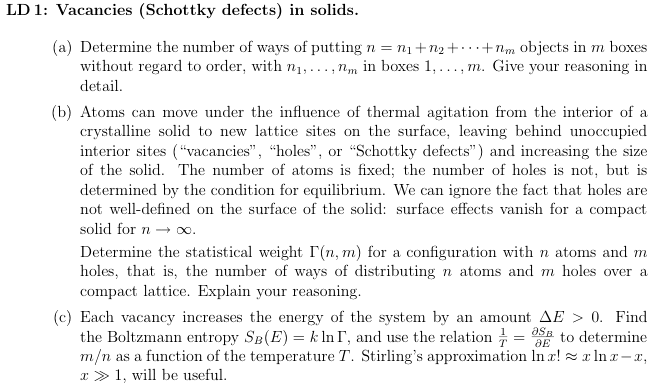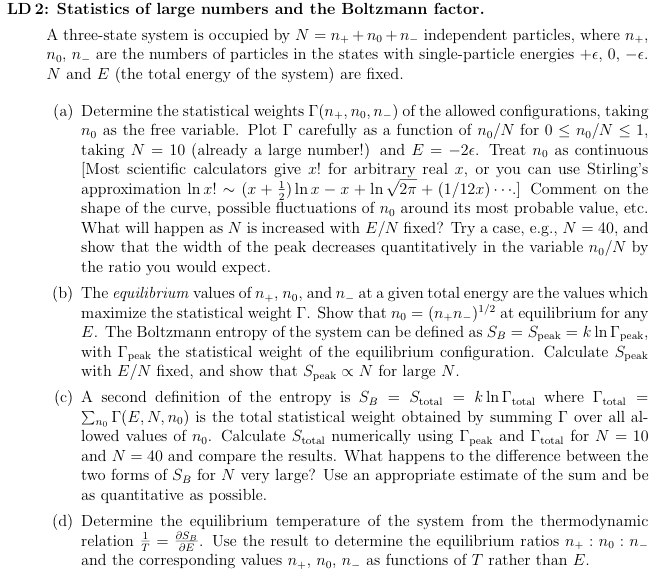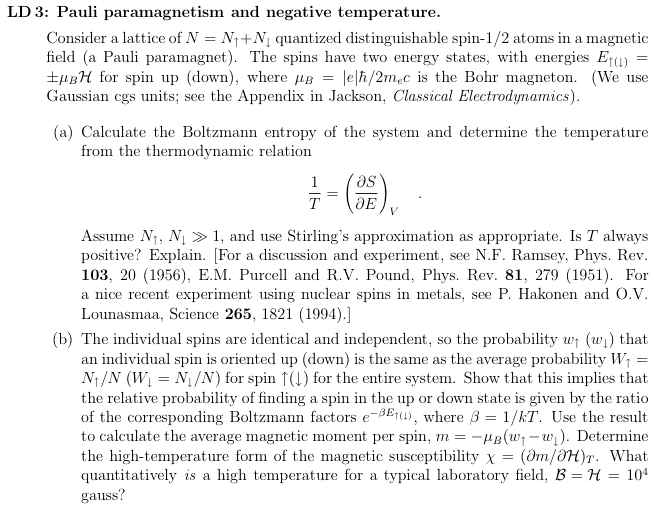
PROBLEM SET 1
Due Friday, January 27, 2006
Reading: Landau and Lifshitz, Chap. 1, Secs. 9-15, 23-25 (review of thermodynamics)

|
Hint: In part (b), think about the final configuration of the
system ignoring surface effects. It is neither necessary nor especially useful
to try to describe microscopically how the system got there. This
concentration on the final configuration is
typical for problems in equilibrium statistical mechanics as contrasted, for example, to problems in kinetic theory
|
||
|
Comments: LD1 is a typical counting problem
in condensed matter physics. The connection with thermodynamics
and the behavior of vacancies in real solids
comes in through the use of Boltzmann's definition of the entropy in terms
of the statistical weight, and the observation that each vacancy costs
a finite excitation energy quantum mechanically.
Note that 1/T is initially just an abbreviation for a particular derivative of S. The connection with the usual temperature can be established by showing that T is the same for two systems in equilibrium, and that it can be connected to a measureable property such as the pressure in a gas thermometer. We will demonstrate these properties later. The temperature of the solid could then be measured using a gas thermometer in equilibrium with it. Why is the result you get not given by a simple Boltzmann factor? |

|
Comments: LD2 illustrates several properties of large systems. Note the
following, in particular:
(a) The statistical weights are very large. Even 10 is a large number. It is therefore useful to use logarithms and Stirling's approximation for the gamma function or factorial, and treat the weight as continuous even for numerical work. The weight is very sharply peaked about its maximum value for N large. (b) It is sufficient here (but not in the numerical calculatons in (a)) to use the truncated form of Stirling's approximation, x! = x ln x - x + .... Why are two situations different?
(c) can be treated as a numerical problem. The Boltzmann entropy S is an extensive quantity proportional to N
up to negligible non-extensive corrections of order ln N.
The two different
definitions of the entropy also give the same result up to
logarithmic corrections. If you want to see
analytically what is going on, expand ln (d) The relative weights with which the numbers of particles in different substates appear are given by the expected ratios of Boltzmann factors once T is introduced. This result, which is not at all obvious in the original statement of the problem, is again generic for large systems. |

Comments: Note the units! We will generally use
Gaussian cgs units in dealing with microscopic problems. They do not
contain the annoying factors  and
and  needed to get to SI units, and the speed of light c appears
explicitly as needed for relativistic problems. In part (b),
H is the energy or Hamiltonian of a single spin.
needed to get to SI units, and the speed of light c appears
explicitly as needed for relativistic problems. In part (b),
H is the energy or Hamiltonian of a single spin.
This problem deals with Pauli's theory of spin paramagnetism, a quantum phenomenon, as a simple counting problem using the Boltzmann definition of the entropy. The natural parameter for describing statistical systems is the inverse temperature 1/T as we will see later in discussing Gibbs' approach to statistical mechanics. This parameter can vary from plus infinity (T --> 0+) to minus infinity (T --> 0-), and goes smoothly through zero at infinite T, with an accompanying change in the sign of T. It is therefore sometimes said rather colorfully that negative temperatures are "hotter" than infinite temperatures. Negative temperatures can actually be produced in isolated systems that remain out of equilibrium with their surroundings for a long time. See the references given. |